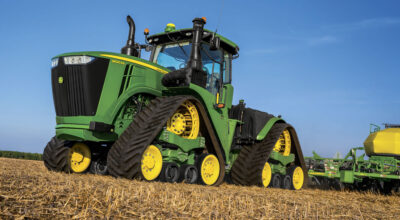Maintaining your John Deere equipment is essential to ensure it lasts for years to come. If you own a track tractor, the track belt might be one thing you have to mind along the way. Preconditioning new track belts can help you get more out of your John Deere track tractor over time, but what about routine maintenance? Here are a few video overviews of how to maintain the track belt and keep your machinery in working order.
Maximizing Track Belt Life – Part 1
How your new John Deere track tractor operates within its first 50 to 100 hours of life can impact the life of the track belt. For this reason, it’s crucial to be proactive about maintenance from the start. Be sure to expose new or clean tracks to dry and dusty soil as soon as possible. Then, precondition your belts before driving the tractor on the road, operating in moist soil, or operating in winter on frozen ground. Belts are preconditioned by periodically applying dry and dusty soil to the area between the wheels and belts. If dry soil is not an option, a clay-based lubricant, such as dry oil and/or kelp powder, can be used.
Maximizing Track Belt Life – Part 2
Toe adjustment procedures on John Deere 8RX tractors may be necessary to prevent wear and tear on the track belt over time. When starting out, operators need to ensure that the tracks are correctly tensioned. Next, they should drive the tractor straight forward with no steering or brake input on a flat surface for at least 50 feet. Then, the tractor should be put in neutral and coast to a stop. On the front side of the axel, the distance between the pads on the inside left and on the inside right should be measured. Then, the measurements should be repeated on the opposite side. With this information, the toe setting can be determined by calculating the difference between the front and rear measurements.
Maximizing Track Belt Life – Part 3
A 3×8 inch shim can help operators check track alignment and make adjustments as needed. To begin, operators should drive their tractor straight forward on flat ground with no steering or brake input for a minimum of 150 feet before allowing it to roll to a stop. With the engine off and the tractor in park, the shim should be placed between the track lugs and front mid-roller on the outboard side of the track. This process should then be repeated on the inboard side of the track. If the shim slides easily between the front mid-roller and track lug, both sides of the track are correctly aligned.
Maximizing Track Belt Life – Part 4
Be sure to avoid excessive roading of track tractors to maximize track belt life. If operators need to road their track tractors regularly, several factors need to be considered, including high ambient temperature, lack of lubrication during roading, distance traveled, and ground speed. Operators should reduce speed by 1 mile per hour for every 15 degrees Fahrenheit above 75 degrees Fahrenheit. Soil can be used as a lubricant after every 10 miles traveled.
If you have any questions about the John Deere track tractors, you can contact your local John Deere dealer.
If you enjoyed this post or want to read others, feel free to connect with us on Facebook, Pinterest, or Twitter!



